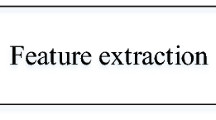Abstract
Mammographic density is strongly associated with breast cancer, being considered one of the most important risk indicators for the development of this type of disease. Likewise, the sensitivity of automatic breast lesion detection systems is significantly dependent on breast tissue characteristics. Therefore, the measurement of density is definitely useful for detecting breast cancer. The aim of this work is to adapt our previously developed automatic breast tissue density classification methodology for digitized mammograms to full-field digital mammograms (FFDM), as well as to evaluate the possible improvements and the classification results. After breast area extraction and peripheral enhancement, the method segments the breast area into fatty and dense tissue, then morphological and texture features from each class are extracted and finally FFDM are classified according to a standard qualitative criteria. Results show a strong correlation (κ = 0.88) between automatic and expert assessments and a better classification correction percentage (CCP = 92%) compared to our earlier work.
Access this chapter
Tax calculation will be finalised at checkout
Purchases are for personal use only
Preview
Unable to display preview. Download preview PDF.
Similar content being viewed by others
References
Allwein, E.L., Schapire, R.E., Singer, Y.: Reducing multiclass to binary: A unifying approach for margin classifiers. J. Mach. Learn. Res. 1, 113–141 (2000)
Boyd, N.F., Lockwood, G.A., Byng, J.W., Tritchler, D.L., Yaffe, M.J.: Mammographic densities and breast cancer risk. Cancer Epidem. Biomarkers Prev. 7(12), 1133–1144 (1998)
Breiman, L.: Random forests. Mach. Learn. 45(1), 5–32 (2001)
Cortes, C., Vapnik, V.: Support-vector networks. Mach. Learn. 20(3), 273–297 (1995)
Freund, Y., Schapire, R.E.: Experiments with a new boosting algorithm. In: Int. Conf. Mach. Learn. / Conf. Uncert. Art. Intell. / Conf. Learn. Theory, pp. 148–156 (1996)
Guyon, I., Weston, J., Barnhill, S., Vapnik, V.: Gene selection for cancer classification using support vector machines. Mach. Learn. 46, 389–422 (2002)
Heath, M., Bowyer, K., Kopans, D., Moore, R., Kegelmeyer, P.J.: The Digital Database for Screening Mammography. In: Int. Work. Dig. Mammography, pp. 212–218 (2000)
Highnam, R., Brady, S.M., Yaffe, M.J., Karssemeijer, N., Harvey, J.: Robust Breast Composition Measurement - VolparaTM. In: Martí, J., Oliver, A., Freixenet, J., Martí, R. (eds.) IWDM 2010. LNCS, vol. 6136, pp. 342–349. Springer, Heidelberg (2010)
Jolliffe, I.T.: Principal Component Analysis, 2nd edn. Springer (2002)
Karssemeijer, N., te Brake, G.M.: Combining single view features and asymmetry for detection of mass lesions. In: Int. Work. Dig. Mammography, pp. 95–102 (1998)
Kwok, S.M., Chandrasekhar, R., Attikiouzel, Y., Rickard, M.T.: Automatic pectoral muscle segmentation on mediolateral oblique view mammograms. IEEE Trans. Med. Imag. 23(9), 1129–1140 (2004)
American College of Radiology. Illustrated Breast Imaging Reporting and Data System BIRADS, 3rd edn. American College of Radiology (1998)
Oliver, A., Freixenet, J., Martí, J., Pérez, E., Pont, J., Denton, E.R.E., Zwiggelaar, R.: A review of automatic mass detection and segmentation in mammographic images. Med. Image Anal. 14(2), 87–110 (2010)
Oliver, A., Freixenet, J., Martí, R., Pont, J., Pérez, E., Denton, E.R.E., Zwiggelaar, R.: A novel breast tissue density classification methodology. IEEE Trans. Inform. Technol. Biomed. 12(1), 55–65 (2008)
Romero, C., Varela, C., Cuena, R., Almenar, A., Pinto, J.M., Botella, M.: Impact of mammographic breast density on computer-assisted detection (CAD) in a breast imaging department. Radiología 53(5), 456–461 (2011)
Suckling, J., Parker, J., Dance, D.R., Astley, S.M., Hutt, I., Boggis, C.R.M., Ricketts, I., Stamatakis, E., Cerneaz, N., Kok, S.L., Taylor, P., Betal, D., Savage, J.: The Mammographic Image Analysis Society digital mammogram database. In: Int. Work. Dig. Mammography, pp. 211–221 (1994)
Witten, I.H., Frank, E.: Data Mining Pactical Machine Learning Tools and Technique, 3rd edn. Morgan Kaufmann (2005)
Witten, I.H., Frank, E., Hall, M.A.: Data Mining: Practical machine learning tools and techniques, 3rd edn. Morgan Kaufmann (2011)
Author information
Authors and Affiliations
Editor information
Editors and Affiliations
Rights and permissions
Copyright information
© 2012 Springer-Verlag Berlin Heidelberg
About this paper
Cite this paper
Tortajada, M. et al. (2012). Adapting Breast Density Classification from Digitized to Full-Field Digital Mammograms. In: Maidment, A.D.A., Bakic, P.R., Gavenonis, S. (eds) Breast Imaging. IWDM 2012. Lecture Notes in Computer Science, vol 7361. Springer, Berlin, Heidelberg. https://doi.org/10.1007/978-3-642-31271-7_72
Download citation
DOI: https://doi.org/10.1007/978-3-642-31271-7_72
Publisher Name: Springer, Berlin, Heidelberg
Print ISBN: 978-3-642-31270-0
Online ISBN: 978-3-642-31271-7
eBook Packages: Computer ScienceComputer Science (R0)




